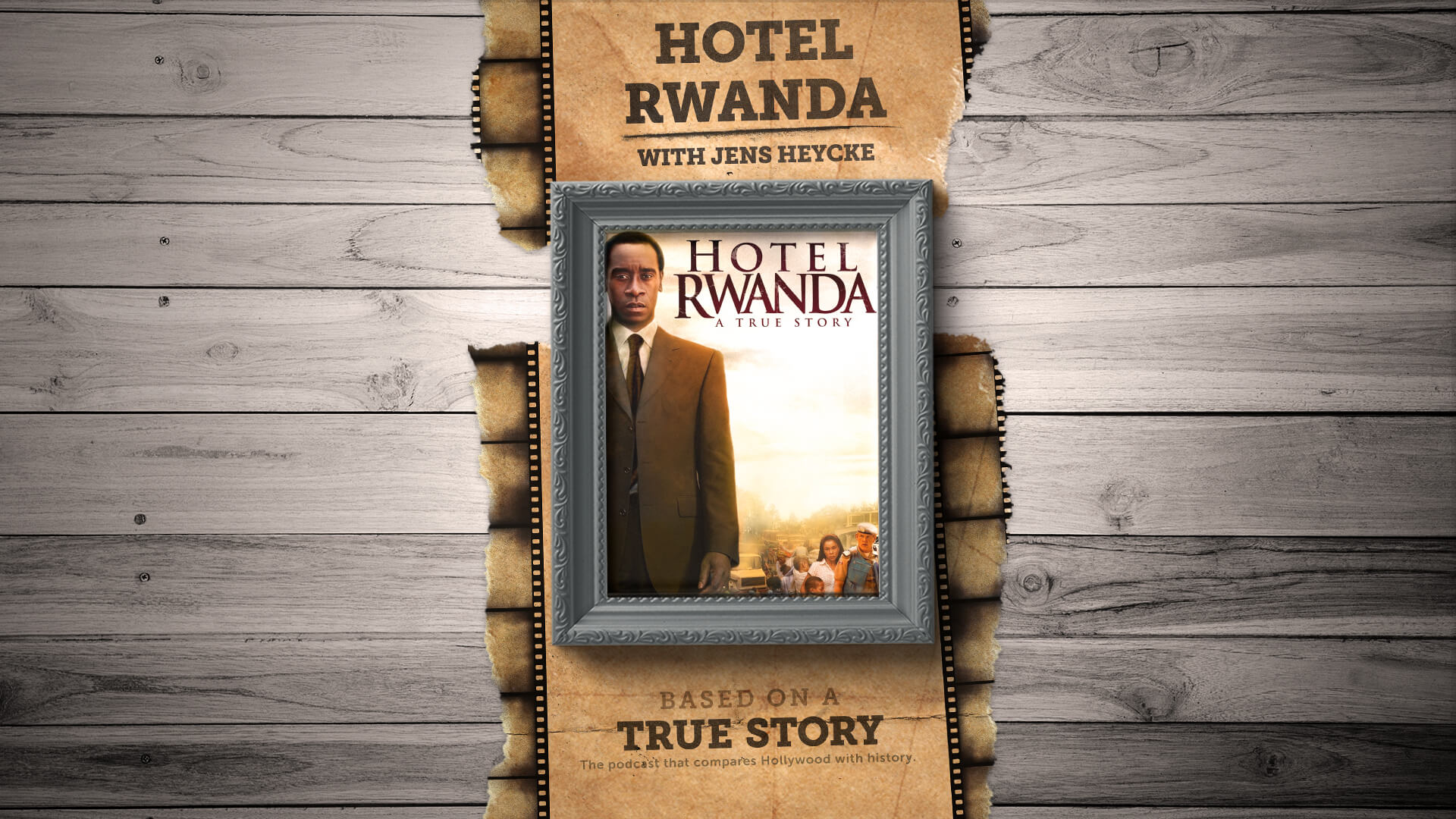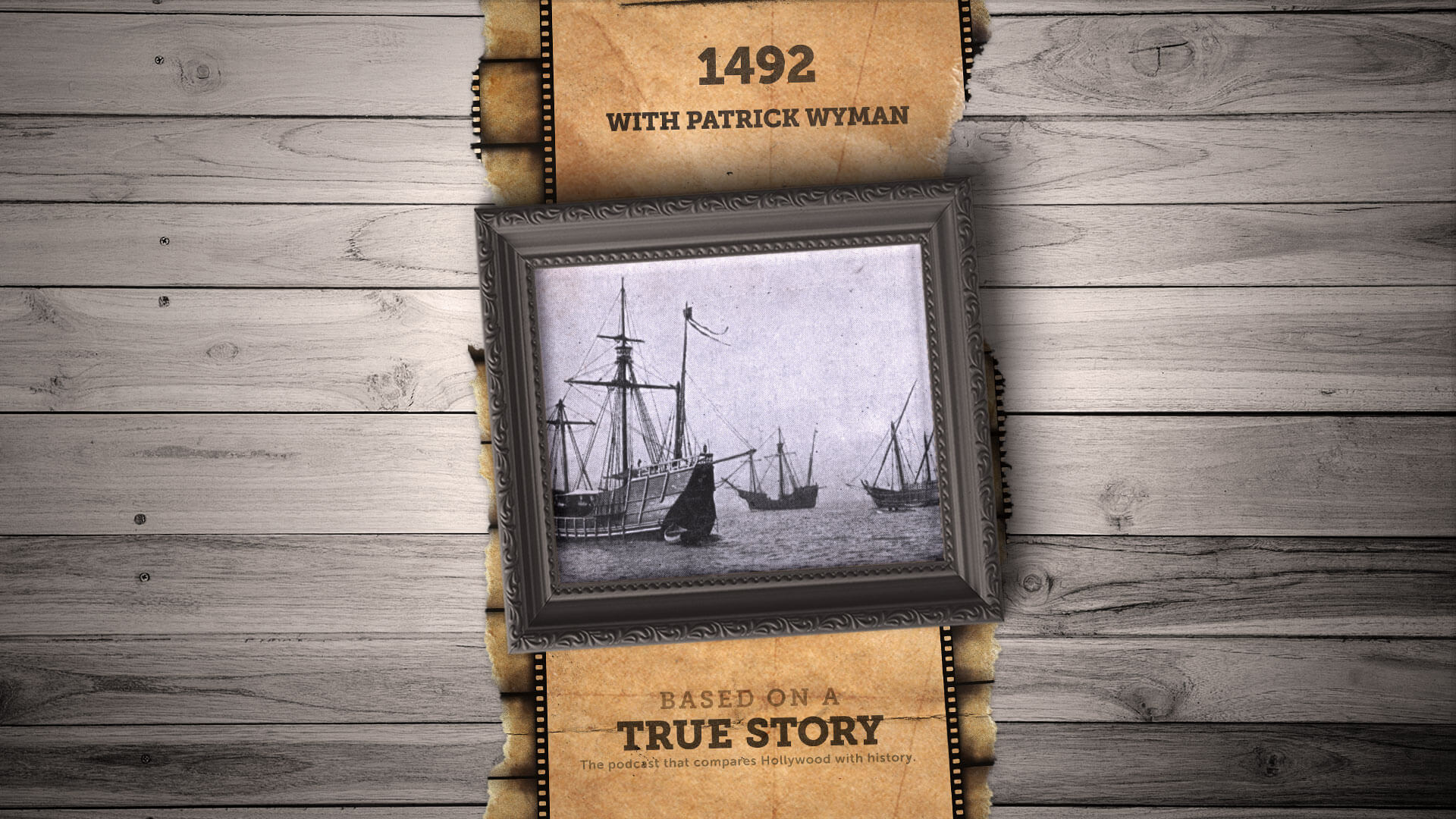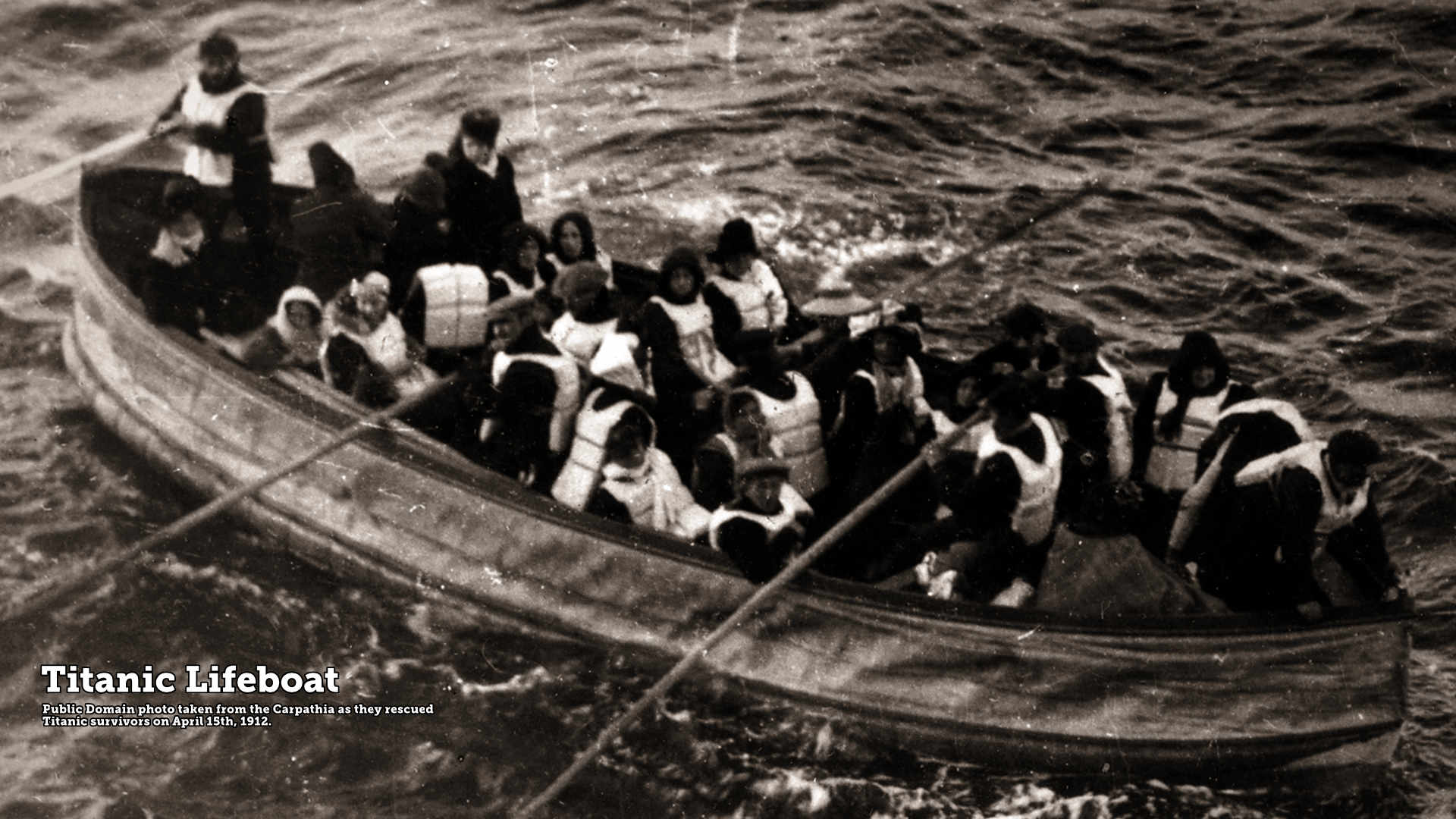On this episode, we’ll learn about historical events that happened this week in history as they were depicted in Malcolm X, Flags of Our Fathers and Patton.
Did you enjoy this episode? Help support the next one!
Disclaimer: Dan LeFebvre and/or Based on a True Story may earn commissions from qualifying purchases through our links on this page.
Transcript
Note: This transcript is automatically generated. There will be mistakes, so please don’t use them for quotes. It is provided for reference use to find things better in the audio.
February 21, 1965. New York City.
On the wooden floor are rows of wooden chairs. Most of them are filled with people although not all of them. A family walks down the aisle to find their seats when one of the children drops her doll on the ground. A man behind the family notices it and picks it up for her, smiling as he returns it to the grateful little girl.
We can see the room better now. All the chairs are facing a stage with curtains.
Outside, we can see the name of the building: Audubon Ballroom.
Back inside, we’re backstage now and we can see two men talking to each other. They say the minister hasn’t arrived yet, but he’ll be here.
Sure enough, outside, we see Denzel Washington’s version of Malcolm X pull up to the building in an Oldsmobile. A woman outside recognizes him and says she’ll pray for him. Jesus will protect you, she says, but we can see tears in his eyes.
He’s inside now, greeting the two men who were wondering where he was a moment ago. As they’re preparing, one of the men sits down to talk to him one-on-one. He can sense something is wrong like he shouldn’t go out there.
Walking out of the backstage area, he stands in front of a now crowded room of people. It doesn’t look like there are any empty seats anymore.
Everyone claps enthusiastically as Malcolm is introduced.
He walks up to the podium.
We can see the faces of some of the men in the crowd who look incredibly angry. This includes the man who picked up the toy for one of Malcolm’s daughters earlier.
Just as Malcolm addresses the crowd, someone in the back stands up and yells at the man next to him to get his hands out of his pockets. Then, someone toward the back throws down something that looks like it was on fire. Smoke starts to fill as everyone gets up out of their seats.
Security guards rush to the back to see what’s going on.
With everyone focused on the commotion in the back, a man rushes up to the front with a shotgun. Malcolm just looks at him for a moment before the man blasts Malcolm. A second blast from the shotgun now and Malcolm falls backward.
Malcolm’s wife, who was in the audience, screams.
Two more men rush to the front with pistols and fire even more rounds into Malcolm as he lie bleeding out on the stage.
The camera cuts to Malcolm’s daughters, one of whom is still clutching the toy that the man who is now shooting her father handed to her just a moment ago.
Then, the men join the chaos of everyone else running out of the room.
This depiction comes from the 1992 movie named after the man played by Denzel Washington, Malcolm X.
The true story is very similar to what we see depicted in the movie.
There were about 400 people in the audience at the Audubon Ballroom in the Manhattan borough of New York City on the afternoon of February 21st, 1965. Just like we see in the movie, that included Malcolm’s wife, Betty, and their children. They were in the front row.
In the movie, we can tell that Denzel’s version of Malcolm knew someone was trying to kill him. And that would be a correct impression, because there’s every indication that he knew someone was trying to kill him.
While it wasn’t this week in history so I didn’t mention it in the depiction of his assassination, earlier in the movie we did see Malcolm’s home firebombed. That actually happened on Valentine’s Day, February 14th, 1965. Malcolm knew someone was going to kill him. In his own autobiography, Malcolm said, “I do not expect to live long enough to read this book in its finished form.”
Sadly, he was right.
The movie’s depiction of three men, one with a sawed-off shotgun and the other two with pistols, is also accurate. This is a quote from an official FBI document from February 22nd, 1965 about the assassination. You’ll hear beeping in this quote and that’s not swearing but those are the parts where the FBI has censored the document before they released it to the public:
Malcolm K. Little, leader of the Muslim Mosque, Incorporated (MMI), and the Organization of Afro-American Unity (OAAU), was shot and killed on the afternoon of February 21, 1965, at approximately 3:10 p.m. while speaking at a meeting of the OAAU being held in the Audubon Ballroom 166th Street and Broadway, New York City. The New York Office was immediately advised of the incident _______________ who was present at the meeting.
_______________ was _______________ at the back of the hall when someone in the audience called out indicating that his pocket had been picked. _______________ observed two men standing near the front of the hall in about the third or fourth row, apparently firing some sort of weapons. He also recalls seeing two other men standing at the time, one several feet behind the first two, and the other several feet to the side. He presumed that they were also involved in the shooting. _______________two shots and saw Malcolm X fall backward to the floor. He then heard a volley of shots, probably twenty. _______________ believes the assailants were also shooting at Malcolm’s guards. At this point, _______________ ran to the foyer of the hall and _______________ which commanded a view of the entrance to the hall. He observed a man, later identified as John Hagen, running down the aisle crouching and weaving with a .45 caliber pistol in his hand.
Malcolm X was hit at least 15 times at point blank range. He was declared dead at the hospital he was rushed to about 15 minutes later.
If you want to watch the depiction of the event that happened this week in history, check out the 1992 movie called Malcolm X. The assassination sequence starts at about two hours and 58 minutes into the movie.
But if you want to learn more about the true, we covered that movie in a lot more depth on episode #128 of Based on a True Story.
February 23, 1945. Iwo Jima.
The front of the landing vehicle hits with a boom as it falls open, allowing the soldiers inside to walk off onto the beach. Looking up, one of the first things they notice is a flag flapping in the wind high above, on the mountain that overlooks the beach.
One of the men who steps off is Secretary Forrestal, who is played by Michael Cumpsty in the movie. He tells Holland next to him that he wants that flag.
A phone call is made.
Robert Patrick’s character, Colonel Chandler Johnson, answers the phone and says he’ll get the flag for Forrestal. Then, as soon as he gets off the phone, Johnson yells and screams in frustration that some politician is going to get the flag that the Marines fought hard to put there.
But an order is an order.
Johnson tells Neal McDonough’s character, Captain Severance, to get him the flag and find another one to replace it.
In the next scene, we can some Marines coming down the mountain as others stream up it. One of the men climbing the mountain is photographer Joe Rosenthal and a passing Marine comments that he missed a beautiful shot. Rosenthal just replies that it’s been that kind of a day.
When they get to the top, Jesse Bradford’s character, Rene Gagnon, relays the order from Captain Severance to get the flag. He’s carrying a new flag to replace it. The Lieutenant doesn’t understand why the Captain wants him to take down the flag they just put up, but an order is an order.
He hands the new flag to Barry Pepper’s character, Mike Strank, and asks him to put it up. So, as some Marines take down the first flag, Mike Strank and a few other Marines put up a new flag.
While they’re doing that, the two photographers stand by. One is Joe Rosenthal as we already mentioned and the other is Kirk B.R. Woller’s character, Bill Genaust. Rosenthal is shooting photos while Genaust is filming the flag being raised. A few seconds later, the flag is raised and Genaust asks Rosenthal if he got the shot and he says he’s not sure but he sure wishes he could see their faces.
The event we just heard about came from the 2006 movie Flags of Our Fathers, a movie that tells the story of perhaps the most famous photograph from World War II: Raising the flag on Iwo Jima.
The movie is correct to suggest the iconic photograph wasn’t taken at the first raising of a flag at the tallest point of Iwo Jima on Mount Suribachi. That happened earlier on the morning of the 23rd by a combat patrol of the 2nd Battalion, 28th Marines, led by Lieutenant Harold Schrier. Staff Sergeant Louis Lowery was the photographer who captured that event, and you can find his photograph anywhere online.
And here is where some of the controversies begin around the famous photograph.
According to some eyewitness accounts, the flag was too small to be seen from below—Mount Suribachi is about 550 feet tall. That’s about 169 meters. Some accounts also mention the version we see in the movie, that the Secretary of the Navy James Forrestal claimed the flag for his own because that was the very first time an American flag had flown on Japanese soil.
No matter the reason why, we do know for a fact that a second, larger American flag was sent up to the peak to be raised.
While the movie doesn’t address this at all, another, much larger controversy has to do with Ryan Phillipe’s character, John Bradley. He’s the father of James Bradley, the man who wrote the book Flags of Our Fathers that the movie is based on.
You see, originally it was believed that the six flag raisers in the photograph were Henry Hansen, Franklin Sousley, Rene Gagnon, Ira Hayes, Michael Strank and John Bradley. Of those six, the only one who was not a Marine was John Bradley, who was a Navy corpsman.
Then, in 1947, Ira Hayes initiated an investigation and the Marines determined it was Corporal Harlon Block at the base of the photo and not Henry Hansen. And that’s how it stayed for a long time.
After the movie’s release, there was renewed interest in the photograph.
In 2014, two amateur historians, Eric Krelle and Stephen Foley, noted some discrepancies in the uniform and equipment carried by the man previously believed to be John Bradley.
The Marines launched an investigation to reevaluate the photograph, in 2016, the Marine’s Huly Panel concluded John Bradley was not in the photo but instead Private First Class Harold Schultz was. Then, later, Stephen Foley again along with two other historians, Dustin Spence and Brent Westemeyer, suggested there might be another misidentification. And in 2019, the identifications were revised again and it wasn’t Rene Gagnon but rather Corporal Harold Keller.
So, the updated lineup would be Corporal Harlon Block at the base of the flagpole, then Private First Class Harold Keller, Private First Class Franklin Sousley, Sergeant Michael Strank, Private First Class Harold Schultz and Private First Class Ira Hayes.
If you want to take a deep dive into the Marine Corps’ investigation, you can find the eBook called Investigating Iwo: The Flag Raisings in Myth, Memory, & Espirit de Corps available for free on the Marine Corps University website.
I’ll include a link to that in the show notes for this episode, too.
If you want to watch the event that happened this week in history, check out the 2006 movie Flags of Our Fathers. The scene with the flag raising starts at about an hour and 15 minutes, but the photograph itself is taken at an hour, 20 minutes and 30 seconds.
February 24, 1943. Tunisia.
Dark smoke drifts gently along in the wind as two Army Jeeps drive along a mountain pass. They stop partway to survey the damage.
On the side of the road, it’s littered with destroyed military vehicles, tanks and dead bodies of what are obviously American soldiers. Karl Malden’s character, General Omar Bradley, says that it looks like the reports are true.
One of the soldiers with Bradley reads off a list of the equipment lost along with 1,800 men. After a moment more, they get in their Jeeps and drive on.
This comes from the opening of the classic 1970 film Patton, it depicts a very real event, although the movie only says it’s Kasserine Pass in Tunisia, 1934.
Filling in some more historical context, we know from history that the aftermath we’re seeing in the movie is the Battle of Kasserine Pass that took place between February 19th and February 24th, 1943.
That’s why, at the beginning of this segment, I used the date of February 24th, and I’ll admit it is an assumption of mine but seeing American General Omar Bradley driving through Kasserine Pass makes me think the battle is over.
And the true story is that about 22,000 or so Germans under the command of Field Marshal Erwin Rommel inflicted heavy casualties on the 30,000 or so Allies. The movie mentions 1,800 men, although it doesn’t really clarify if they’re only talking about American soldiers or also including the British and French who were also there. For the Allies, there were heavy losses in equipment and tanks along with almost 10,000 casualties, 6,500 of which were Americans.
Despite this, the Allies managed to hold off the Axis forces on February 22nd long enough for Rommel to decide to exit. We now think a lot of that had to do with the Germans’ supply lines being overextended.
So, when the Germans started to return to their defensive positions closer to the coast, that meant between February 22nd and February 24th, the Allies were able to reoccupy Kasserine Pass.
As a result of this battle, Allied General Eisenhower decided to restructure the forces in the African Theatre. One change he made was to bring in General George S. Patton which, of course, explains why this battle was depicted in the beginning of the 1970 Patton film.
If you want to watch the event that happened this week in history, we see Kasserine Pass only about eight minutes into the movie.
And if you want to dig deeper into the true story behind that movie, we covered it over on episode #163 of Based on a True Story.
Share this:
- Click to share on Twitter (Opens in new window)
- Click to share on Facebook (Opens in new window)
- Click to share on Reddit (Opens in new window)
- Click to share on Pocket (Opens in new window)
- Click to share on LinkedIn (Opens in new window)
- Click to share on WhatsApp (Opens in new window)
- Click to share on Telegram (Opens in new window)
- Click to email a link to a friend (Opens in new window)
- Click to print (Opens in new window)



